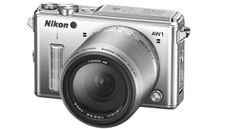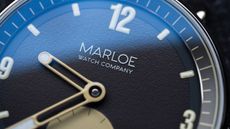The Nikon 1 AW1 is dustproof, freeze proof, shock proof and waterproof down to 15 metres - and you can swap the lens
Is the Nikon 1 AW1 the brand's best compact system camera of the past three years? We think so. Not only does it do all that its predecessors did and more - save for notably omitting the eye-level viewfinder seen on the Nikon V1 and V2 - but it is also its beefiest to date.
Yes the 14.2 megapixel Nikon 1 system AW1 can be dropped from a height of two metres and be frozen to -10°C without malfunctions, avoid dust intruding into its most sensitive parts, and accompany budding Cousteaus down to watery depths of 15 metres; so suggests its manufacturer.
The real thing to shout about here though is that not only is this Nikon the first and so far only interchangeable lens camera to offer such extensive destruction proofing, it is also the first to achieve it without the aid of any additional housing. You can simply dunk the camera as is into the drink.
Yes the pricer Olympus OMD E-M1 is also freeze proof, splash proof and dust proof, but we wouldn't risk dropping or going diving with it.
Such innovation has been achieved via O-ring strength sealing and rubber padding, plus double lock covers for output ports and battery and card compartments at the side and at the base respectively.
Nikon 1 AW1: Lenses
Unsurprisingly, any lens attached needs to share the camera body's near indestructible qualities and at present there are just two options (though more are promised): the 11-27.5mm f/3.5-5.6 standard kit zoom (roughly 29mm to 74mm in 35mm terms) supplied with our review sample, plus a standalone 10mm wide angle lens at a slightly brighter f/2.8 announced alongside it.
Even the tip of the lens has a rubber-padded ring to prevent damage, while as you twist the lens barrel it travels within its own sealed housing, rather than extending and retracting from the camera body. There's no built-in Wi-Fi, but wireless transfer can be achieved via an optional plug-in dongle. But why worry about that when we're also given a height and depth gauge and a built-in electric compass?
Nikon 1 AW1: Waterproofing
Not living near the roar of the ocean or the snowiest of peaks, the next best thing for our underwater testing was dunking the AW1 with lens attached in the Thames and our local pond.
We're pleased to report it survived the stygian depths of both, though we did notice that moisture had intruded within the battery/card compartment; thankfully it had stopped short of making contact with either.
It was a similar story when peeking beneath the cover for the output ports at the side, where we discovered a few small droplets had snuck in just beneath the protective flap.
Fortunately the camera was still in perfect working order - even if we can't attest for how it would perform after an hour under water at 15m; which is as far as its manufacturer's claim stretches.
Whether you think spending £750 on this camera and lens is a sound buy depends on how much you'd value more professional looking pictures - which is what, ultimately, this compact system camera is promising - where you wouldn't normally dream of taking a camera.
Though the AW1 could be interpreted as a niche/specialist product, we found that over a couple of weeks of testing that it actually makes quite a good all-purpose one. You can continue taking pictures in a downpour without fretting, and if the camera gets dirty and muddy you can simply wash it clean under the tap.
But naturally we're also concerned here with how the AW1 handles as a tool for capturing photos and videos pure and simple, and how good said imagery is. Have either been compromised at all in order to achieve the body and lenses' ruggedness? Read on...
Nikon 1 AW1: Controls
Like the J series models (such as the Nikon 1 J2 and J3) lower down Nikon's 1 system camera range, the AW1 offers up a minimalist and rather boxy design, with large industrial-looking lugs for attaching a strap either side of the almost completely flat faceplate.
We had the matt black finished version in for review, though the silver and the white alternatives are also very attractive.
There is what Nikon terms a handgrip provided here, but in truth it's more of a thin sliver with roughed surface to stop fingers slipping, rather than a hand actually gripping. This meant that with wet fingers we did find the camera a little more slippery that would be ideal; perhaps a roughened surface to the entire faceplate for next time guys?
What's noticeably missing here is a physical shooting mode wheel; these are instead accessed by pressing buttons at the back. The top plate then maintains a clean line, broken only by the raised shutter release button for shooting stills plus a video record button alongside it.
This proximity of controls threw up another minor issue for us; we felt it was a little easy to hit video record instead of the shutter release when caught up in the moment, and frustratingly got a few seconds of video when we wanted a still.
Fortunately the power button is flush to the body to prevent such accidental activation, and the pop-up flash - which can also be used underwater - is neatly hidden over at the other side, with an antenna for built-in GPS sitting in the middle.
This means that there is no vacant hotshoe provided, the usual means by which other camera accessories are attached to a non waterproofed CSC in this premium price bracket.
Backplate controls are as small and coolly minimalist as we'd expect to find on a non-ruggedised camera. So at first it doesn't feel like much concession has been made here to anyone who might be operating the camera with gloves.
However, Nikon has a hidden trick up its proverbial sleeve. Hold down the marginally raised button where your thumb naturally comes to rest at the top right of the rear plate. This brings up a virtual shooting mode dial on screen.
Tilt the camera left and right and the on-screen dial turns accordingly until you arrive at your chosen setting, without additional button pushing required.
The selectable choice here includes the standard creative quartet of program, shutter priority, aperture priority and manual modes, along with an actual creative mode providing access to the likes of self-stitching panoramas and digital effects such as miniaturisation and soft focus - automatically applied at the point of capture.
In addition we're provided with standard features in the Nikon 1 range such as the gimmicky Motion Snapshot, which combines a few seconds of video with a still to look as if your shot has come to life, plus a best shot mode that shoots up to 20 sequential images and either allows you to select the best or suggests its preferred choices to you.
In other words the AW1 provides the opportunity to just point and shoot if you want to, or get more hands on with manual and creative settings if your mood and window of photographic opportunity allows.
Nikon 1 AW1: Screen
Without any eye-level optical or electronic viewfinder supplied here - which in fairness would have made for a bulkier overall model - we're wholly reliant on the 3-inch, 4:3 ratio LCD screen for composing and reviewing pictures and video on the AW1.
Fortunately then this provides a respectable semi pro spec of 921K dots resolution, so we're able to check detail and fidelity of focus pretty easily, even when holding the camera even at arm's length.
OK, so ideally in such circumstances a tilting LCD screen would have been a further luxury, but doubtless that idea was nixed here due to the fact that such a mechanism would be one of the easiest to break with deliberate rough treatment. Still the screen brightness is able to adjust, so a clear picture is offered whatever the weather.
Nikon 1 AW1: Battery
The AW1's rechargeable lithium ion battery slots into a double lockable compartment at the camera's base, which is shared with the optional, removable SD/SDHC/SDXC media card. We also get a standalone charger and mains plug provided, so the camera doesn't need to be tied up every time the power is depleted, if you've been thoughtful enough to invest in a spare.
Nikon has been shy in its press notes about suggesting an officially confirmed battery life, but in practice we took over 200 images and found that our camera's battery was still showing two thirds life remaining.
Nikon 1 AW1: Picture quality
Said image quality is as top hole as you'd expect from a camera and glass costing £750 in combination - even without the 'extra' of the destruction proofing here.
As this is a Nikon we also get consistency of white balance and detail from shot to shot, while the solidity of the camera with lens combined appeared to make our shots less susceptible to the blurring effects of hand wobble, even when we were shooting only with available light (without flash).
That said, in offering a maximum ISO setting of ISO6400 it feels Nikon has been a little cautious. But whatever, the results here speak for themselves, while the effects filters, whilst fewer than you'd get on the average smartphone these days, are both fun and effective.
It's a cinch to shoot video here too - and the fact that we get stereo sound to accompany our 1920x1080 pixels clips makes for an altogether more life-like result when watching them back.
Obviously as the zoom is operated manually with a twist of the wrist it too can be used during recording, while another upshot is that the lack of on-board mechanics that might otherwise result in the in-built mics picking up a low operational buzz makes the supplied lens a boon for shooting video.
What was perhaps most impressive was that we didn't notice the camera's auto focus making its usual adjustments as we altered framing; it's that quick.
One note of caution however: we did occasionally experience the interior of the protective lens glass - i.e that protecting the lens itself - misting up on the inside when moving between extremes of temperature, as a pair of spectacles would.
More silt-like water droplets are also slower to run free of the lens glass, so can show up in images. But as long as you're aware of this, a quick rub down with a shirt-tail or handkerchief rights the issue.
Nikon 1 AW1: Verdict
The waterproof, drop-proof, freeze-proof and dust-proof AW1 is currently one of a kind when it comes to compact-styled interchangeable lens cameras.
Whether that means that, with kit zoom, a price tag around £750 is justified depends on your shooting requirements.
For ski and snowboarding fans as well as those who like to venture into the deep, the AW1 represents a fuss free, no-extras-required solution and it's smaller and arguably cheaper than a DSLR plus housing - even if various consumer camera housings will now allow you to venture down to 40 metres, which is considerably deeper than the otherwise respectable 15 metres offered by this Nikon CSC.
But more than this, if you don't care about the lack of eye-level viewfinder the AW1 may very well be Nikon's best compact system camera yet, and certainly comes by default with a build that feels more workhorse-like than the fashion accessory styled J models lower down the range. Altogether recommended, if you can stump up the cash.
Nikon 1 AW1 release date: Out now
Nikon 1 AW1 price: £749.99





